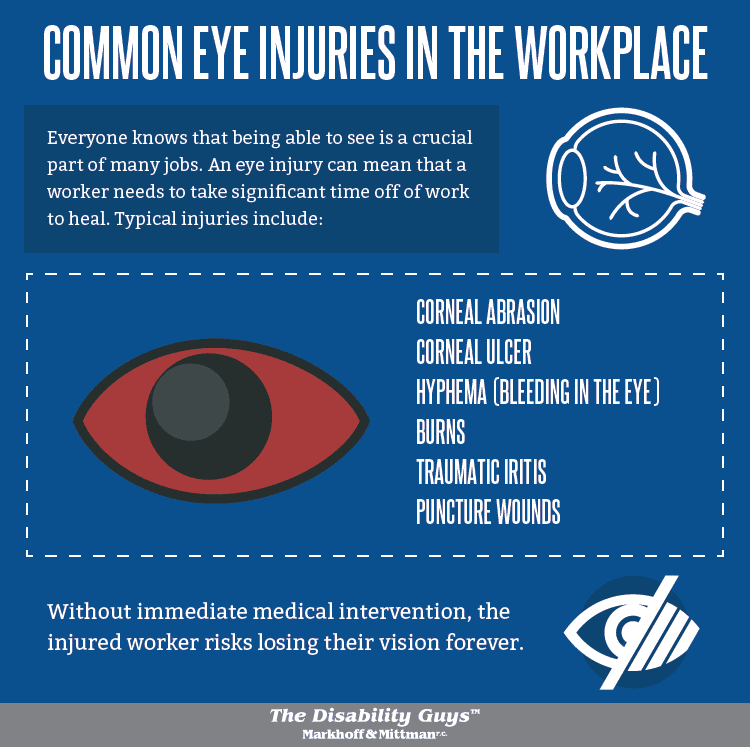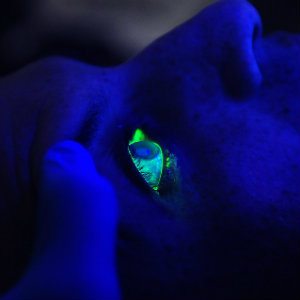The Centers for Disease Control and Prevention have reported a surprising statistic, that every single day, around 2000 Americans suffer a job-related injury to one or both eyes and require medical treatment. It isn’t just injuries that can cause damage to an eye either, infectious diseases or repetitive exposure to certain lights or radiation can also cause harm.
Common Causes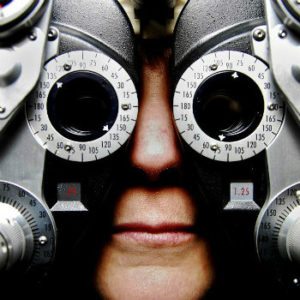
Damage to the eye can be caused by:
- Wood Chips
- Cement Chips
- Metal Slivers
- Nails
- UV Radiation
- Chemical Exposure
- Infectious Disease
- Fire / Sparks
- A Blow To The Eye
If left untreated, any of the resulting medical conditions can become extremely painful and leave a patient with reduced or total vision loss, or even result in a total loss of the eye.
How To Recognize Damage To The Eye
Knowing the signs of an eye injury or illness is very important because the sooner that a condition is diagnosed and treated, the less likely the patient is to lose their vision or eye. Symptoms may include:
- Changes in vision
- Reduced movement in the eye
- Bleeding in any part of the eye
- A change in pupil size or shape
- Sensitivity to light
- An inability to close or open the eyelids completely
- Swelling around the eye socket
- A feeling of something foreign in the eye
- Constant tearing
Types of Eye Injuries
Many injured workers suffer from common injuries such as:
Corneal Abrasion
A corneal abrasion is a scratch on the cornea. Typically this type of injury is caused when they are poked in the eye with a foreign object.
Corneal Ulcer
Many times, if a small abrasion or other injury to the eye is left untreated, it can develop into a sore or ulcer on the cornea. This condition is very painful and without medical attention can result in blindness or the loss of the eye.
Hyphema
Hyphema is bleeding in a specific part of the eye, in the anterior chamber of the eye between the cornea and the iris, often caused by a blunt force trauma. This medical condition needs immediate medical attention so that doctors can save both the victim’s vision and eye.
Burns
Both excessive heat and chemical exposure can result in a burn to the eye. Chemicals don’t even need to be directly splashed into the eye, simply rubbing a hand which has come into contact with the chemical in the eye can result in serious damage.
Did you know that if the eye is exposed to a chemical that it only takes an average of 6 – 8 second for that chemical to soak through and penetrate the outer membrane of the eye? This means that it literally only takes a couple of seconds for damage to begin to occur.
Chemical Exposure Can End A Career
Each year, between 7% – 18% of all workplace injuries involve the eye and a large percentage of eye injuries occur because of chemical exposure. Exposures involve one of two type of chemical substances:
Acids
The term acid is used for any substance that has a pH less than 7. Although most people understand that exposing any body part to acid can be extraordinarily dangerous, the fact is that acid exposures actually tend to cause less damage to the eye alkali substances.
When an acid comes into contact with the eye, it typically “denatures”, essentially forming a barrier on the cornea which prevents the acid from sinking deeper into the tissues of the eye. However, that being said, this doesn’t mean that acid exposure shouldn’t be taken very seriously and treated immediately as permanent damage does occur.
Examples of acids that are commonly used in workplaces include: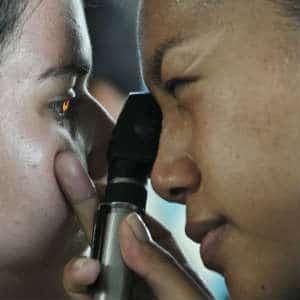
- Suphamic Acid
- Sulphuric Acid
- Hydrochloric Acid
- Hydrofluoric Acid
- Nitric Acid
- Boric Acid
- Phosphoric Acid
In addition to permanent damage to the eye, if acid burns occur over more than just 2% of the body, the patient is at risk for developing life-threatening hypocalcemia.
Alkalis
When a substance has a pH greater than 7, it is an alkali. These chemicals are typically lipophilic which means they have a tendency to combine with fats. As a result, alkalis penetrate the eye easily and allow for deeper penetration into the tissues of the eye.
Common examples of alkali substances commonly found in the workplace include:
- Ammonia
- Sodium Hydroxide
- Calcium Hydroxide
- Potassium Hydroxide
Chemical Burn Injuries Are Graded By Severity
As with many injuries, there are “grades” assigned to the damage done to the eye by chemicals. The Grades are:
Grade I
This is the least severe injury and all of the damage is typically on the corneal epithelium, the chemical has not penetrated deep into the eye. Overall patients with this type of injury are likely to fully recover without long-term issues with their vision.
Grade II
Visually there may be a corneal haze, and some damage to the cornea may be observed. Patients with this type of injury have a good prognosis although permanent damage to the cornea may occur.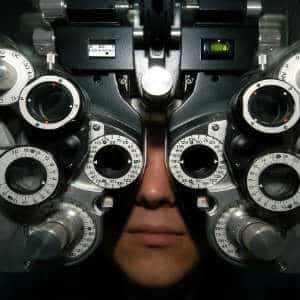
Grade III
This is when the chemical has penetrated deep into the eye, damaging the limbus, corneal, other parts of the eye. In many cases, vision is unable to be completely restored and in order to obtain the best outcome, the patient usually has to undergo a surgical procedure.
Grade IV
When the eye has a grade IV injury, the cornea melts and all parts of the eye may be damaged. This type of injury most often results in total loss of vision.
If immediate action is taken in the seconds following an accidental exposure, the injured employee can help to prevent further damage, however, employers need to ensure that the employee has the resources and training that they need.
Training should include information on all chemicals that could potentially damage the eye and the location of important emergency items such as eye wash stations and showers. It’s important to remember that all employees should be trained to find showers and stations through memory and touch, because if both eyes are involved, they may be temporarily blinded.
Penetrating Objects
Wood chips, metal, and other random objects can easily penetrate the eye. Victims should never try to remove the object themselves as it may cause additional damage. Covering the eye with a cup until help is obtained is an excellent way to prevent further injury.
Traumatic Iritis
This is when there is inflammation in the colored part of the eye, usually due to a blow from a blunt object. If the condition isn’t treated as soon as possible, there is a chance that permanent damage will occur and the victim’s vision will be impacted.
Share this Image On Your Site
OSHA Safety Standards
Per OSHA standards, employers are required to provide employees working in certain industries with proper eye protection. The suitable eyewear varies from job to job and is determined based on the types of hazards that one might expect to encounter while at work. For example, while simple, open-air glasses may be enough to protect a construction worker who is cutting wood with a saw, it is not suitable for a welder who needs a full face mask.
The Different Types Of Eye Protection
There are several types of materials used today for protective glasses, including:
Glass Lenses
Glass is not easily scratched, can be specially made to have a corrective prescription, and can be used around harsh chemicals without damage. Larger glasses, however, can become quite heavy and uncomfortable. These glasses can also fog quite easily, obstructing the wearer’s vision.
Plastic Lenses
While plastic lenses are light and comfortable and is less likely to fog, it does have its downsides. Plastic is not as scratch resistant as glass and cannot be used around certain chemicals.
Polycarbonate Lenses
Polycarbonate lenses are lightweight, unlikely to fog up, can protect a user against welding splatter, and is stronger and for impact resistant than both plastic and glass. However, these lenses are also not as scratch resistant as glass.
What To Do If You Injure Your Eye At Work
If you or a loved one suffered an eye injury at work, seeking medical attention as quickly as possible is the first thing that you should do.
Once you have received the proper medical attention, document the accident. Inform your employer, in writing, about what caused the accident and the injuries that were sustained. Be sure to take photographs of the issue that resulted in the accident as well as your injuries. If anyone witnessed your accident, request their contact information.
While it may be possible that all of your financial and medical needs will be met through a workers’ compensation claim, many victims find that they need to pursue a third party complaint in order to get what they need. In these cases, a well-documented accident will ensure that you get the maximum amount possible in compensation.
What Can I Do If I’ve Lost My Sight & Can’t Work?
If a work accident resulted in the loss of your sight and you are unable to continue working as a result, you may have several legal options:
Workers’ Comp
All employers are required by law to have workers’ comp insurance and once a work injury has occurred, that worker can file a claim. This claim may provide compensation for medical bills and lost wages.
Social Security Disability
Social Security Disability claims provide payments to those who can no longer work due to a disability injury or illness.
Personal Injury Lawsuit
When an accident or exposure occurs because of a mistake make by a third-party, the injured worker may have the option to file a lawsuit against the party responsible. Compensation from this lawsuit may cover all past and future medical expenses, lost wages, physical suffering, and emotional trauma.
The attorneys at Markhoff & Mittman can help you identify all possible forms of compensation and assist you through the entire legal process. Contact us today to learn more.

